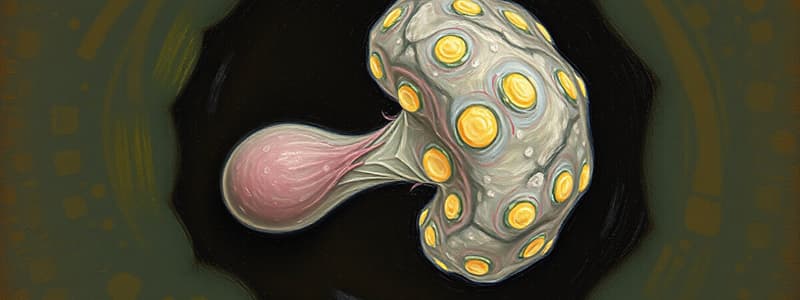Podcast
Questions and Answers
What is the function of the sodium-potassium pump?
What is the function of the sodium-potassium pump?
To pump sodium ions out of the cell and potassium ions into the cell.
The source of energy used to power the sodium-potassium pump is the breakdown of ATP.
The source of energy used to power the sodium-potassium pump is the breakdown of ATP.
True (A)
During one cycle, the sodium-potassium pump binds and moves 3Na+ and 2K+.
During one cycle, the sodium-potassium pump binds and moves 3Na+ and 2K+.
True (A)
The sodium-potassium pump is a trans-membrane protein.
The sodium-potassium pump is a trans-membrane protein.
The binding and releasing of sodium or potassium ions are due to conformational changes in the protein.
The binding and releasing of sodium or potassium ions are due to conformational changes in the protein.
The sodium-potassium exchange pump is an example of active transport.
The sodium-potassium exchange pump is an example of active transport.
Active transport moves substances from an area of high concentration to an area of low concentration.
Active transport moves substances from an area of high concentration to an area of low concentration.
What are lysosomes?
What are lysosomes?
The lysosome contains hydrolytic enzymes.
The lysosome contains hydrolytic enzymes.
Phagocytosing white blood cells are expected to contain the most active lysosomes.
Phagocytosing white blood cells are expected to contain the most active lysosomes.
The lysosome's function is the destruction and recycling of old organelles.
The lysosome's function is the destruction and recycling of old organelles.
The enzymes found in lysosomes were formed in the endoplasmic reticulum.
The enzymes found in lysosomes were formed in the endoplasmic reticulum.
Flashcards are hidden until you start studying
Study Notes
Sodium-Potassium Pump
- The sodium-potassium pump actively transports sodium ions out of cells and potassium ions into cells, crucial for maintaining cellular homeostasis.
- ATP breakdown provides the energy necessary for the pump's function, highlighting its role in active transport.
- Each cycle of the pump moves three sodium ions (Na+) out and two potassium ions (K+) into the cell, establishing concentration gradients essential for various cellular processes.
- The pump is a trans-membrane protein that spans the cell membrane, demonstrating its integral role in cellular mechanisms.
Mechanism of Action
- Binding and releasing of Na+ and K+ ions involves conformational changes in the sodium-potassium pump, ensuring effective ion exchange.
- The sodium-potassium pump exemplifies active transport, wherein substances are moved against their concentration gradients, a process essential for nutrient absorption and cellular signaling.
Lysosomes
- Lysosomes are membrane-bound vesicles that originate from the Golgi apparatus and are essential for various cellular processes.
- They contain hydrolytic enzymes that break down waste materials and cellular debris, aiding in cellular maintenance.
- Phagocytic white blood cells are rich in lysosomes, reflecting their active role in degrading pathogens and recycling components.
- Lysosomes contribute to the destruction and recycling of old organelles, promoting cellular health and longevity.
- Enzymes located in lysosomes are synthesized in the endoplasmic reticulum, linking different organelles' functions within the cell.
Studying That Suits You
Use AI to generate personalized quizzes and flashcards to suit your learning preferences.




